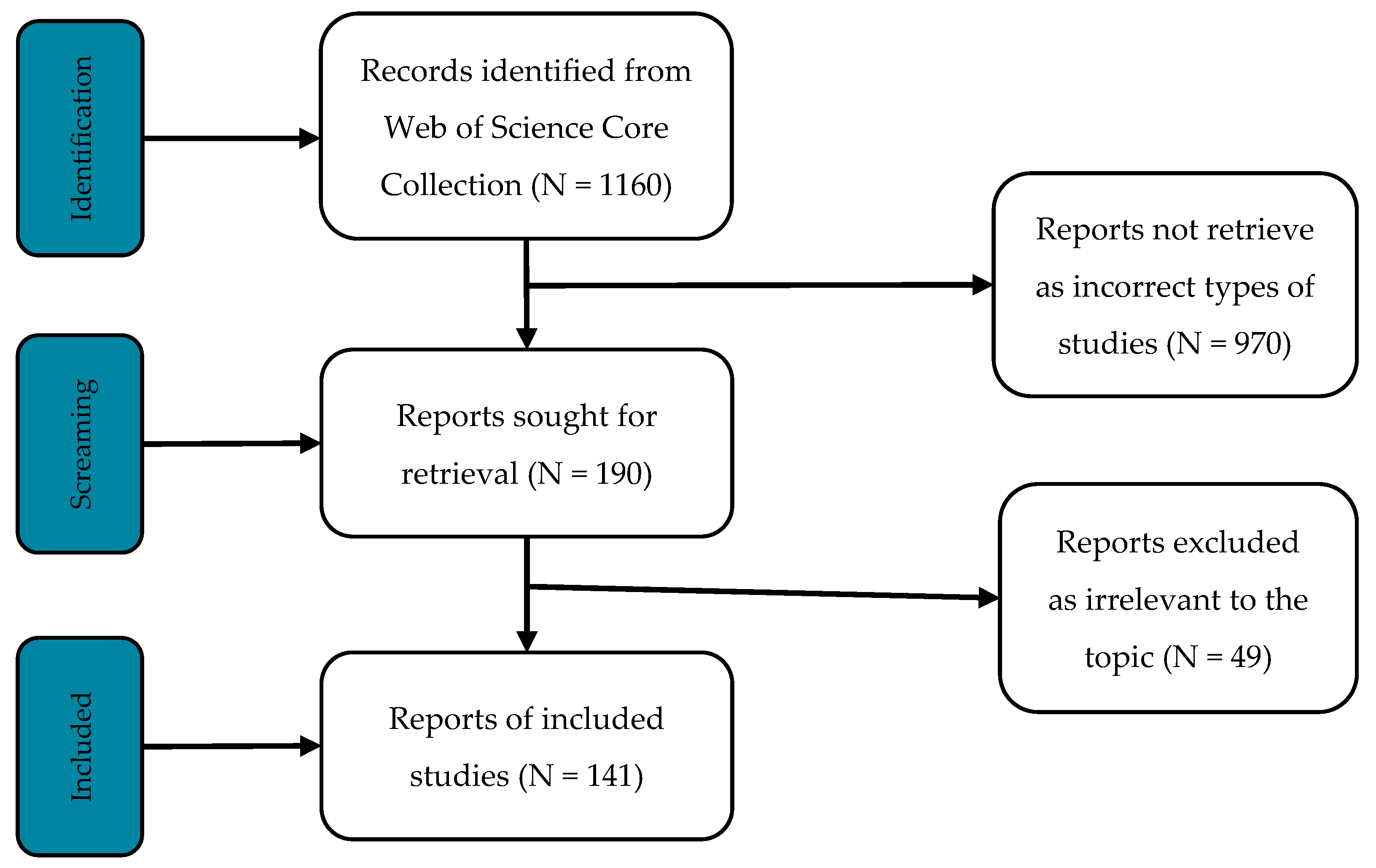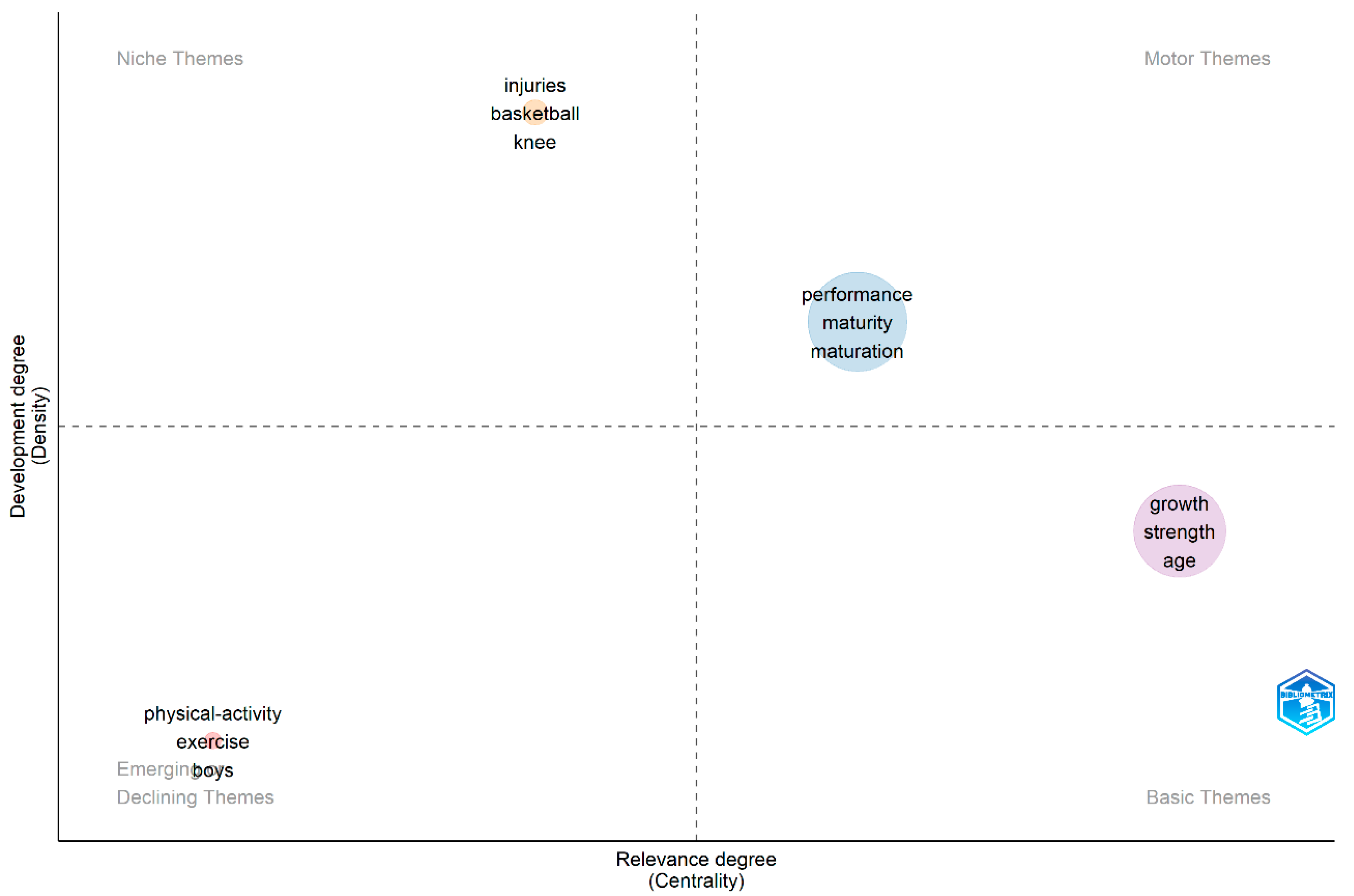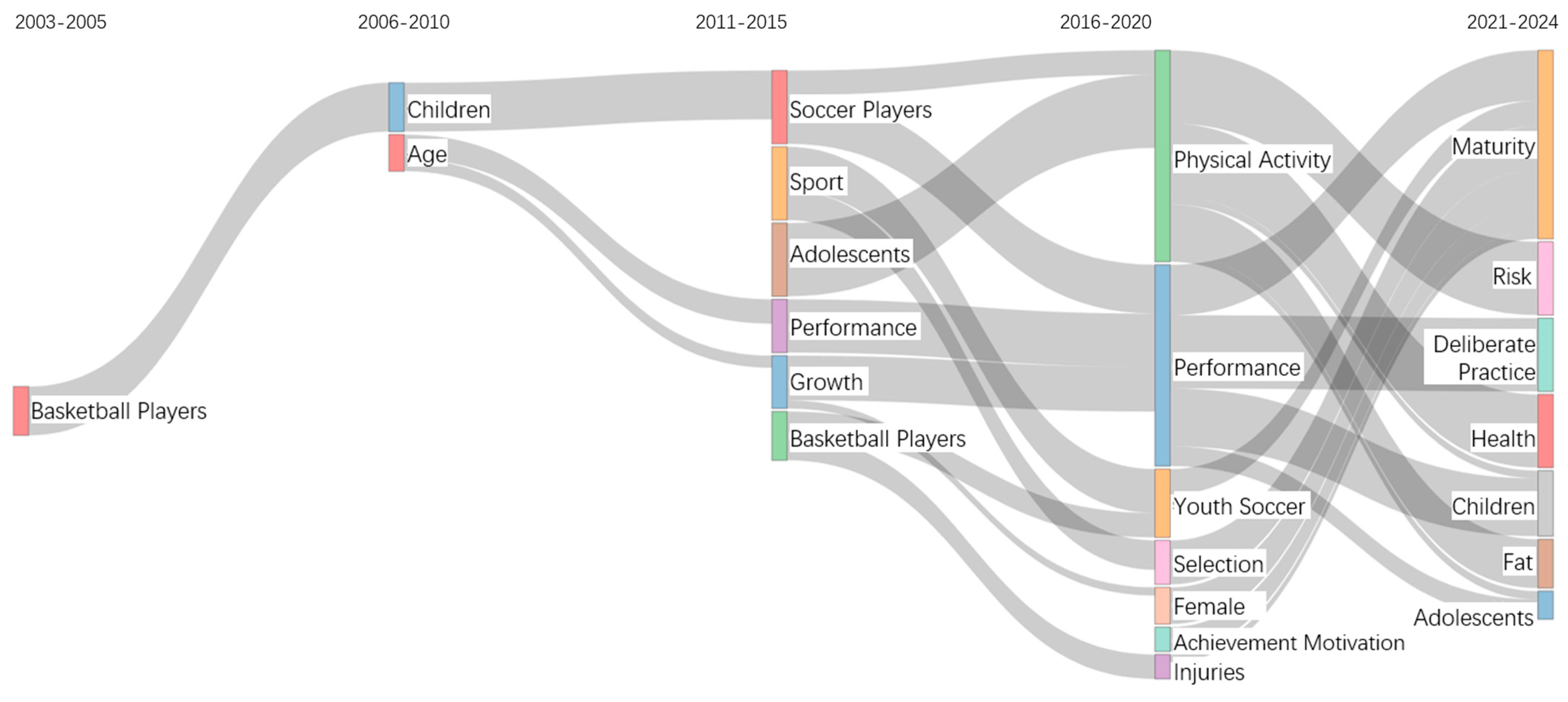Exploring the Structure of Growth and Maturation Research Among Basketball Players Using R Tools †
Abstract
1. Introduction
2. Methods
2.1. Source of Data and Search Strategy
2.2. Inclusion and Exclusion Criteria
- Articles designed to investigate issues related to the growth and maturation within basketball.
- Only articles written in English were considered eligible.
- Articles that do not relate to investigating issues related to the growth and maturation within basketball. Examples include studies focusing solely on other team sports, or those that do not emphasize basketball players.
- Records related to announcements and book reviews were excluded, focusing solely on published research papers. For example, an announcement about an upcoming conference or a book review discussing the contents of a newly published book was excluded.
- The paper time span was set from 1 January 2003 to 31 August 2024 to examine the trend over the past years. Any papers published outside this period were excluded.
2.3. Analytical Methods
3. Results
3.1. General Overview
3.2. Publications Analysis Considering Contributions of the Main Authors
3.3. Evolutionary Path Analysis Based on Timeline Diagrams
3.3.1. Timeline Analysis of Research Themes
3.3.2. Thematic Evolution in Youth Sports Research
4. Discussion
5. Conclusions
Author Contributions
Funding
Conflicts of Interest
References
- Ford, P.; De Ste Croix, M.; Lloyd, R.; Meyers, R.; Moosavi, M.; Oliver, J.; Till, K.; Williams, C. The Long-Term Athlete Development Model: Physiological Evidence and Application. J. Sports Sci. 2011, 29, 389–402. [Google Scholar] [CrossRef] [PubMed]
- Baker, J.; Cobley, S.; Schorer, J. Talent Identification and Development in Sport: International Perspectives. Int. J. Sports Sci. Coach. 2012, 7, 177–180. [Google Scholar] [CrossRef]
- Baquet, G.; van Praagh, E.; Berthoin, S. Endurance Training and Aerobic Fitness in Young People. Sports Med. 2003, 33, 1127–1143. [Google Scholar] [CrossRef]
- Naughton, G.; Farpour-Lambert, N.J.; Carlson, J.; Bradney, M.; Van Praagh, E. Physiological Issues Surrounding the Performance of Adolescent Athletes. Sports Med. 2000, 30, 309–325. [Google Scholar] [CrossRef] [PubMed]
- Balyi, I. Long-Term Athlete Development: Trainability in Childhood and Adolescence Windows of Opportunity, Optimal Trainability; United States Olympic Committee: Colorado Springs, CO, USA, 2004. [Google Scholar]
- Simwanza, A.; Paul, A. Models for Youth Sports Talent Identification and Development: An Integrative Review of Research. Gift. Talent. Int. 2023, 38, 164–176. [Google Scholar] [CrossRef]
- Kalén, A.; Padrón-Cabo, A.; Lundkvist, E.; Rey, E.; Pérez-Ferreirós, A. Talent Selection Strategies and Relationship with Success in European Basketball National Team Programs. Front. Psychol. 2021, 12, 666839. [Google Scholar] [CrossRef]
- Leite, N.; Borges, J.; Santos, S.; Sampaio, J. The Relative Age Effect in School and Federative Sport in Basketball. Rev. Psicol. Deporte 2013, 22, 219–223. [Google Scholar]
- Sabato, T.M.; Walch, T.J.; Caine, D.J. The Elite Young Athlete: Strategies to Ensure Physical and Emotional Health. Open Access J. Sports Med. 2016, 7, 99–113. [Google Scholar] [CrossRef]
- Ribeiro, J.; Davids, K.; Silva, P.; Coutinho, P.; Barreira, D.; Garganta, J. Talent Development in Sport Requires Athlete Enrichment: Contemporary Insights from a Nonlinear Pedagogy and the Athletic Skills Model. Sports Med. 2021, 51, 1115–1122. [Google Scholar] [CrossRef]
- Moreno-Pérez, V.; Ruiz, J.; Vazquez-Guerrero, J.; Rodas, G.; Del Coso, J. Training and Competition Injury Epidemiology in Professional Basketball Players: A Prospective Observational Study. Phys. Sportsmed. 2023, 51, 121–128. [Google Scholar] [CrossRef]
- Stojanović, E.; Stojiljković, N.; Scanlan, A.; Dalbo, V.; Berkelmans, D.; Milanović, Z. The Activity Demands and Physiological Responses Encountered during Basketball Match-Play: A Systematic Review. Sports Med. 2018, 48, 111–135. [Google Scholar] [CrossRef] [PubMed]
- Thompson, D.F.; Walker, C.K. A Descriptive and Historical Review of Bibliometrics with Applications to Medical Sciences. Pharmacother. J. Hum. Pharmacol. Drug Ther. 2015, 35, 551–559. [Google Scholar] [CrossRef]
- Durieux, V.; Gevenois, P.A. Bibliometric Indicators: Quality Measurements of Scientific Publication. Radiology 2010, 255, 342–351. [Google Scholar] [CrossRef] [PubMed]
- Tanselle, G.T. Notes on Recent Work in Descriptive Bibliography. Stud. Bibliogr. 2018, 60, 1–93. [Google Scholar] [CrossRef]
- Orr, M.; Inoue, Y.; Seymour, R.; Dingle, G. Impacts of Climate Change on Organized Sport: A Scoping Review. WIREs Clim. Change 2022, 13, e760. [Google Scholar] [CrossRef]
- Noh, H.; Jo, Y.; Lee, S. Keyword Selection and Processing Strategy for Applying Text Mining to Patent Analysis. Expert Syst. Appl. 2015, 42, 4348–4360. [Google Scholar] [CrossRef]
- de-la-Fuente-Robles, Y.-M.; Ricoy-Cano, A.-J.; Albín-Rodríguez, A.-P.; López-Ruiz, J.L.; Espinilla-Estévez, M. Past, Present and Future of Research on Wearable Technologies for Healthcare: A Bibliometric Analysis Using Scopus. Sensors 2022, 22, 8599. [Google Scholar] [CrossRef]
- Denche, Á.; Escudero Tena, A.; Pereira-Payo, D.; Adsuar, J.; Muñoz, D. Scientific Mapping of the State-of-the-Art in Padel. A Bibliometric Analysis. Int. J. Sports Sci. Coach. 2023, 19, 1275–1285. [Google Scholar] [CrossRef]
- Liu, T.; Wassell, N.; Liu, J.; Zhang, M. Mapping Research Trends of Adapted Sport from 2001 to 2020: A Bibliometric Analysis. Int. J. Environ. Res. Public. Health 2022, 19, 12644. [Google Scholar] [CrossRef]
- Braun, V.; Clarke, V. Reflecting on Reflexive Thematic Analysis. Qual. Res. Sport Exerc. Health 2019, 11, 589–597. [Google Scholar] [CrossRef]
- Zhu, X.; Turney, P.; Lemire, D.; Vellino, A. Measuring Academic Influence: Not All Citations Are Equal. J. Assoc. Inf. Sci. Technol. 2015, 66, 408–427. [Google Scholar] [CrossRef]
- Kastner, M.; Antony, J.; Soobiah, C.; Straus, S.; Tricco, A. Conceptual Recommendations for Selecting the Most Appropriate Knowledge Synthesis Method to Answer Research Questions Related to Complex Evidence. J. Clin. Epidemiol. 2016, 73, 43–49. [Google Scholar] [CrossRef] [PubMed]
- Thomas, A.; Gupta, V. Tacit Knowledge in Organizations: Bibliometrics and a Framework-Based Systematic Review of Antecedents, Outcomes, Theories, Methods and Future Directions. J. Knowl. Manag. 2021, 26, 1014–1041. [Google Scholar] [CrossRef]
- Arede, J.; Fernandes, J.F.T.; Freitas, T.T.; Gonzalo-Skok, O.; Leite, N. Biological Maturation, Contextual Factors, and Future Career in Basketball: A Possible Interrelationship? J. Sports Sci. 2023, 41, 1944–1951. [Google Scholar] [CrossRef]
- Leyhr, D.; Rösch, D.; Cumming, S.; Höner, O. Selection-Dependent Differences in Youth Elite Basketball Players’ Relative Age, Maturation-Related Characteristics, and Motor Performance. Res. Q. Exerc. Sport 2024, 95, 775–788. [Google Scholar] [CrossRef]
- Malina, R.M.; Eisenmann, J.C.; Cumming, S.P.; Ribeiro, B.; Aroso, J. Maturity-Associated Variation in the Growth and Functional Capacities of Youth Football (Soccer) Players 13–15 Years. Eur. J. Appl. Physiol. 2004, 91, 555–562. [Google Scholar] [CrossRef]
- de Gouvêa, M.A.; Cyrino, E.S.; Valente-Dos-Santos, J.; Ribeiro, A.S.; da Silva, D.R.P.; Ohara, D.; Coelho-E-Silva, M.J.; Ronque, E.R.V. Comparison of Skillful vs. Less Skilled Young Soccer Players on Anthropometric, Maturation, Physical Fitness and Time of Practice. Int. J. Sports Med. 2017, 38, 384–395. [Google Scholar] [CrossRef]
- Peña, I.; Javaloyes, A.; Moya, M. The Effect of the Maturity Status on Strength Performance in Young Elite Basketball Players (El Efecto Del Estado Madurativo En El Rendimiento Físico de Jóvenes Jugadores de Baloncesto de Élite). Retos 2022, 44, 858–863. [Google Scholar] [CrossRef]
- Birrento-Aguiar, R.A.; Arede, J.; Leite, N.; García-Angulo, F.J.; Pino-Ortega, J.; Ortega-Toro, E. Influence of Two Different Competition Models on Physical Performance in Under-13 Basketball Players: Analysis Considering Maturity Timing. Appl. Sci. 2023, 13, 12125. [Google Scholar] [CrossRef]
- Owoeye, O.; Ghali, B.; Befus, K.; Stilling, C.; Hogg, A.; Choi, J.; Palacios-Derflingher, L.; Pasanen, K.; Emery, C. Epidemiology of All-Complaint Injuries in Youth Basketball. Scand. J. Med. Sci. Sports 2020, 30, 2466–2476. [Google Scholar] [CrossRef]
- Wik, E.; Lolli, L.; Chamari, K.; Materne, O.; Di Salvo, V.; Gregson, W.; Bahr, R. Injury Patterns Differ with Age in Male Youth Football: A Four-Season Prospective Study of 1111 Time-Loss Injuries in an Elite National Academy. Br. J. Sports Med. 2021, 55, 794–800. [Google Scholar] [CrossRef] [PubMed]
- DiFiori, J.; Güllich, A.; Brenner, J.; Côté, J.; Hainline, B.; Ryan, E.; Malina, R. The NBA and Youth Basketball: Recommendations for Promoting a Healthy and Positive Experience. Sports Med. 2018, 48, 2053–2065. [Google Scholar] [CrossRef]
- Pasanen, K.; Ekola, T.; Vasankari, T.; Kannus, P.; Heinonen, A.; Kujala, U.; Parkkari, J. High Ankle Injury Rate in Adolescent Basketball: A 3-Year Prospective Follow-up Study. Scand. J. Med. Sci. Sports 2017, 27, 643–649. [Google Scholar] [CrossRef]
- Hawkins, D.; Metheny, J. Overuse Injuries in Youth Sports: Biomechanical Considerations. Med. Sci. Sports Exerc. 2001, 33, 1701–1707. [Google Scholar] [CrossRef] [PubMed]
- Quatman-Yates, C.; Quatman, C.; Meszaros, A.; Paterno, M.; Hewett, T. A Systematic Review of Sensorimotor Function during Adolescence: A Developmental Stage of Increased Motor Awkwardness? Br. J. Sports Med. 2012, 46, 649–655. [Google Scholar] [CrossRef] [PubMed]
- Malina, R.; Rogol, A.; Cumming, S.; Coelho-e-Silva, M.; Figueiredo, A. Biological Maturation of Youth Athletes: Assessment and Implications. Br. J. Sports Med. 2015, 49, 852–859. [Google Scholar] [CrossRef]
- Sullivan, J.; Roberts, S.J.; Mckeown, J.; Littlewood, M.; McLaren-Towlson, C.; Andrew, M.; Enright, K. Methods to Predict the Timing and Status of Biological Maturation in Male Adolescent Soccer Players: A Narrative Systematic Review. PLoS ONE 2023, 18, e0286768. [Google Scholar] [CrossRef]
- Rommers, N.; Rössler, R.; Goossens, L.; Vaeyens, R.; Lenoir, M.; Witvrouw, E.; D’Hondt, E. Risk of Acute and Overuse Injuries in Youth Elite Soccer Players: Body Size and Growth Matter. J. Sci. Med. Sport 2020, 23, 246–251. [Google Scholar] [CrossRef]
- McAuley, A.; Varley, I.; Herbert, A.; Suraci, B.; Baker, J.; Johnston, K.; Kelly, A. Maturity-Associated Polygenic Profiles of under 12–16-Compared to under 17–23-Year-Old Male English Academy Football Players. Genes 2023, 14, 1431. [Google Scholar] [CrossRef]
- Morris, S. Estimating Effect Sizes from Pretest-Posttest-Control Group Designs. Organ. Res. Methods 2008, 11, 364–386. [Google Scholar] [CrossRef]
- Shang, X.; Arede, J.; Leite, N. Exploring the structure of growth and maturation research among youth basketball players using citation network analysis. In Proceedings of the XII Iberian Basketball Congress, Castelo Branco, Portugal, 7–9 November 2024; Escola Superior de Educação do Instituto Politécnico de Castelo Branco: Castelo Branco, Portugal, 2024. [Google Scholar]
- Saleem, F.; Khattak, A.; Ur Rehman, S.; Ashiq, M. Bibliometric Analysis of Green Marketing Research from 1977 to 2020. Publications 2021, 9, 1. [Google Scholar] [CrossRef]
- Maia, S.C.; de Benedicto, G.C.; do Prado, J.W.; Robb, D.A.; de Almeida Bispo, O.N.; de Brito, M.J. Mapping the Literature on Credit Unions: A Bibliometric Investigation Grounded in Scopus and Web of Science. Scientometrics 2019, 120, 929–960. [Google Scholar] [CrossRef]
- Montazeri, A.; Mohammadi, S.; Hesari, P.M.; Ghaemi, M.; Riazi, H.; Sheikhi-Mobarakeh, Z. Preliminary Guideline for Reporting Bibliometric Reviews of the Biomedical Literature (BIBLIO): A Minimum Requirements. Syst. Rev. 2023, 12, 239. [Google Scholar] [CrossRef]
- Wang, J.-W.; Qu, S.; Zhu, Z.-C.; Zhao, X.; Song, W.-J.; Li, X.; Chen, W.-D.; Luo, D.-M. Global Hotspots and Trends in Research on Preschool Children’s Motor Development from 2012 to 2022: A Bibliometric Analysis. Front. Public Health 2023, 11, 1118674. [Google Scholar] [CrossRef]
- Aria, M.; Cuccurullo, C. Bibliometrix: An r-Tool for Comprehensive Science Mapping Analysis. J. Informetr. 2017, 11, 959–975. [Google Scholar] [CrossRef]
- Gupta, V. An Analysis of Data Visualization Tools. Int. J. Comput. Appl. 2019, 178, 4–7. [Google Scholar] [CrossRef]
- Bridgstock, M. The Quality of Single and Multiple Authored Papers; an Unresolved Problem. Scientometrics 1991, 21, 37–48. [Google Scholar] [CrossRef]
- Linton, J.D.; Tierney, R.; Walsh, S.T. Publish or Perish: How Are Research and Reputation Related? Ser. Rev. 2011, 37, 244–257. [Google Scholar] [CrossRef]
- Al Ardha, M.A.; Nurhasan, N.; Nur, L.; Chaeroni, A.; Ristanto, K.O.; Pembayun, N.S.R.; Yang, C.B.; Lin, J.H.; Putra, K.P.; Putra, N.S.R.P.; et al. Research Publication in Long Term Athlete Development: A Systematic Review and Bibliometric Analysis of Scopus Database in 2009–2023. Retos 2024, 59, 740–749. [Google Scholar] [CrossRef]
- Bergeron, M.F.; Mountjoy, M.; Armstrong, N.; Chia, M.; Côté, J.; Emery, C.A.; Faigenbaum, A.; Hall, G.; Kriemler, S.; Léglise, M.; et al. International Olympic Committee Consensus Statement on Youth Athletic Development. Br. J. Sports Med. 2015, 49, 843–851. [Google Scholar] [CrossRef]
- Lloyd, R.S.; Cronin, J.B.; Faigenbaum, A.D.; Haff, G.G.; Howard, R.; Kraemer, W.J.; Micheli, L.J.; Myer, G.D.; Oliver, J.L. National Strength and Conditioning Association Position Statement on Long-Term Athletic Development. J. Strength Cond. Res. 2016, 30, 1491–1509. [Google Scholar] [CrossRef] [PubMed]
- Huang, W.-Y.; Wu, C.-E.; Huang, H. The Effects of Plyometric Training on the Performance of Three Types of Jumps and Jump Shots in College-Level Male Basketball Athletes. Appl. Sci. 2024, 14, 12015. [Google Scholar] [CrossRef]
- Moran, J.; Liew, B.; Ramirez-Campillo, R.; Granacher, U.; Negra, Y.; Chaabene, H. The Effects of Plyometric Jump Training on Lower-Limb Stiffness in Healthy Individuals: A Meta-Analytical Comparison. J. Sport Health Sci. 2023, 12, 236–245. [Google Scholar] [CrossRef] [PubMed]
- Xu, D.; Zhou, H.; Quan, W.; Ma, X.; Chon, T.-E.; Fernandez, J.; Gusztav, F.; Kovács, A.; Baker, J.S.; Gu, Y. New Insights Optimize Landing Strategies to Reduce Lower Limb Injury Risk. Cyborg Bionic Syst. 2024, 6, 0126. [Google Scholar] [CrossRef]
- Lindahl, J.; Stenling, A.; Lindwall, M.; Colliander, C. Trends and Knowledge Base in Sport and Exercise Psychology Research: A Bibliometric Review Study. Int. Rev. Sport Exerc. Psychol. 2015, 8, 71–94. [Google Scholar] [CrossRef]
- Ciomaga, B. Sport Management: A Bibliometric Study on Central Themes and Trends. Eur. Sport Manag. Q. 2013, 13, 557–578. [Google Scholar] [CrossRef]
- Jain, J.; Walia, N.; Singh, S.; Jain, E. Mapping the Field of Behavioural Biases: A Literature Review Using Bibliometric Analysis. Manag. Rev. Q. 2021, 72, 823–855. [Google Scholar] [CrossRef]
- Zupic, I.; Čater, T. Bibliometric Methods in Management and Organization. Organ. Res. Methods 2015, 18, 429–472. [Google Scholar] [CrossRef]
- Mongeon, P.; Paul-Hus, A. The Journal Coverage of Web of Science and Scopus: A Comparative Analysis. Scientometrics 2015, 106, 213–228. [Google Scholar] [CrossRef]



| Theme Category | Definition | Centrality Range | Density Range |
|---|---|---|---|
| Motor Themes | Highly developed and essential to the field, with strong external connections. | High | High |
| Basic Themes | Broadly relevant but less internally developed, forming the foundation of the field. | High | Low |
| Emerging Themes | Weakly connected and still developing (or disappearing). | Low | Low |
| Niche Themes | Internally well-developed but weakly connected to the broader research field. | Low | High |
| Description | Results |
|---|---|
| Timespan | 2003:2024 |
| Sources (Journals, Books, etc.) | 68 |
| Documents | 141 |
| Annual Growth Rate % | 11.59 |
| Document Average Age | 5.69 |
| Average citations per doc | 22 |
| References | 4461 |
| Keywords Plus (ID) | 469 |
| Author’s Keywords (DE) | 352 |
| Authors | 576 |
| Authors of single-authored docs | 2 |
| Single-authored docs | 2 |
| Co-Authors per Doc | 5.42 |
| International co-authorships % | 52.60 |
| Country | Articles | Articles % | SCP | MCP | MCP % |
|---|---|---|---|---|---|
| PORTUGAL | 31 | 20.13 | 8 | 23 | 74.19 |
| BRAZIL | 24 | 15.58 | 7 | 17 | 70.83 |
| SPAIN | 20 | 12.99 | 13 | 7 | 35.00 |
| AUSTRALIA | 10 | 6.49 | 5 | 5 | 50.00 |
| USA | 9 | 5.84 | 8 | 1 | 11.11 |
| UNITED KINGDOM | 6 | 3.89 | 1 | 5 | 83.33 |
| POLAND | 5 | 3.25 | 3 | 2 | 40.00 |
| GERMANY | 4 | 2.59 | 1 | 3 | 75.00 |
| ITALY | 4 | 2.59 | 2 | 2 | 50.00 |
| CANADA | 3 | 1.95 | 2 | 1 | 33.33 |
Disclaimer/Publisher’s Note: The statements, opinions and data contained in all publications are solely those of the individual author(s) and contributor(s) and not of MDPI and/or the editor(s). MDPI and/or the editor(s) disclaim responsibility for any injury to people or property resulting from any ideas, methods, instructions or products referred to in the content. |
© 2025 by the authors. Licensee MDPI, Basel, Switzerland. This article is an open access article distributed under the terms and conditions of the Creative Commons Attribution (CC BY) license (https://creativecommons.org/licenses/by/4.0/).
Share and Cite
Shang, X.; Arede, J.; Leite, N. Exploring the Structure of Growth and Maturation Research Among Basketball Players Using R Tools. Appl. Sci. 2025, 15, 4411. https://doi.org/10.3390/app15084411
Shang X, Arede J, Leite N. Exploring the Structure of Growth and Maturation Research Among Basketball Players Using R Tools. Applied Sciences. 2025; 15(8):4411. https://doi.org/10.3390/app15084411
Chicago/Turabian StyleShang, Ximing, Jorge Arede, and Nuno Leite. 2025. "Exploring the Structure of Growth and Maturation Research Among Basketball Players Using R Tools" Applied Sciences 15, no. 8: 4411. https://doi.org/10.3390/app15084411
APA StyleShang, X., Arede, J., & Leite, N. (2025). Exploring the Structure of Growth and Maturation Research Among Basketball Players Using R Tools. Applied Sciences, 15(8), 4411. https://doi.org/10.3390/app15084411










